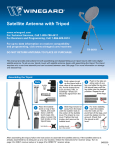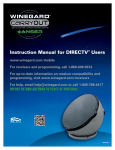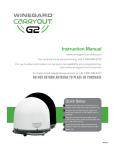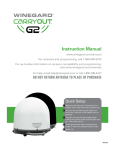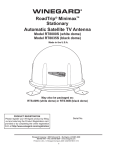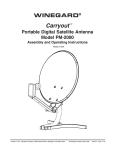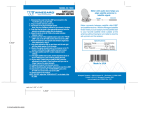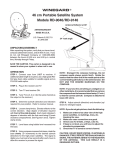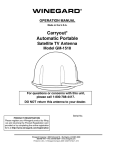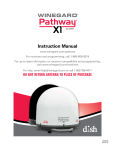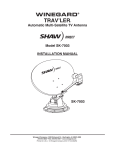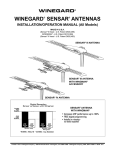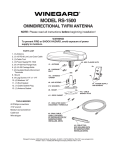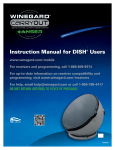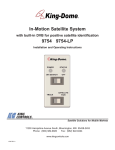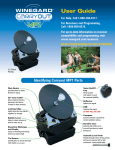Download Winegard TR-6100 User's Manual
Transcript
Satellite Antenna with Tripod www.winegard.com/mobile For Technical Services, email [email protected] or call 1-800-788-4417 For Receivers and Programming, Call 1-866-609-9374 For up-to-date information on receiver compatibility and programming, visit www.winegard.com/receivers TR-6100 DO NOT RETURN ANTENNA TO PLACE OF PURCHASE. This manual provides instructions for both assembling and disassembling your tripod mount with home digital satellite antenna. To set up your tripod mount with satellite antenna, begin with assembling the tripod. The tripod requires only a one-time assembly and can be stored between uses. See page 6 for more information on storage and disassembly. Assembling the Tripod Parts Find a place to set up the tripod with a clear view of the southern sky. Avoid obstructions such as trees, hills, or buildings—these can block the signal from the satellite. 1 legs (3) bubble level storage bag stakes (3) tripod base Push in the tabs on either side of one leg, and slide the leg into the tripod base until the leg locks into the desired position. Repeat for all three legs. 2 tabs 3 Place the bubble level on top of the tripod, and push down until the level snaps into place. Loosen the lock knobs on the tripod base. lock knob Slide legs toward or away from the base until the bubble rests in the center of the bubble level. The tripod is now level. Tighten the lock knobs, and remove the bubble level. 4 bubble should be in the center For extra stability, insert the stakes into the holes on the pivot feet of the legs, and push the stakes into the ground. Check that the tripod is still level. 5 pivot foot After assembling the tripod, follow the instructions to assemble the satellite antenna. If the satellite antenna is already assembled but is being set up at a new location, turn to page 3, and follow the instructions for DISH® receiver setup. 1 Assembling the Satellite Dish Parts DISH Receiver Setup IAB screw (2) integrated adapter bracket (IAB) mast clamp bolt (2) satellite reflector IAB hex nut (2) carriage bolt (4) IAB bolt (2) extra IAB screw 50’ RG-6 coaxial cable support assembly LNBF flange hex nut (6) LNBF arm Line up the four holes on the back of the reflector with the four holes on the support assembly. 1 holes Check that the two posts on the bottom of the IAB have been inserted into the two holes in the LNBF arm. 4 holes Insert the two IAB bolts through the two holes on the bottom of the IAB and through the feed arm. Thread one IAB hex nut on each bolt. 5 Insert a carriage bolt into each of the four holes on the front of the reflector. Thread a flange hex nut on each bolt. 2 Pull apart the IAB. Place the top of the IAB, which slants upwards, and the bottom of the IAB onto the LNBF arm. 3 The following instructions are based on a ViP® 211 receiver. Note that if this is the first time using the receiver, the receiver may automatically jump to step 4 of the instructions below. If your receiver differs from the options shown, you may need to consult your receiver manual. The wording and display used in your receiver may differ slightly. For Technical Services, email [email protected] or call 1-800-788-4417 1 hex nuts hex nuts Feed the RG-6 coaxial cable through the LNBF arm of the support assembly. 6 Before starting, disconnect coax from “Sat in” on back of receiver. 2 Select option 1, Installation. 4 Select Check Switch. Press Menu on your remote. Select option 6, System Setup. Screw the RG-6 coaxial cable onto an available LNBF Output Port. 7 LNBF output port coaxial cable posts DISH receivers will often not show when they are on signal if they have incorrect “Check Switch” information. For this reason, DISH users must clear current settings before pointing. To do this for most DISH receivers, follow these steps. LNBF arm holes Connect the LNBF and the IAB by pushing the parts together. 8 3 bottom of IAB Thread the two IAB 9 screws through the holes on the bottom of the IAB and through the LNBF. Remove the mast 10 clamp bolts, and slide the unit onto the tripod mast. Re-insert the mast clamp bolts, and tighten. Select option 1, Point Dish. If this is the first time using your receiver, your receiver may automatically start with this step. Continue with the DISH Receiver Setup instructions. Tighten all hex nuts after pointing the dish. 11 mast clamp bolts removed bottom of IAB IAB screws 5 Connecting to the Receiver The RG-6 coaxial cable now runs through the LNBF arm of the satellite antenna. Items such as splitters, video switches, and wall plates will stop the satellite signal. Check that there are no checkmarks by SuperDISH or Alternate. Select Test. Continue with step 6 on the next page. 1 For this reason, connect the coaxial cable directly from the satellite antenna to the “Satellite In” port on the back of the satellite receiver. Then, follow the instructions on the next page to set up the DISH receiver. 2 “Satellite In” port Disclaimer: Receiver setup instructions are accurate at time of printing and may change without notice. Call Winegard tech line for assistance: 1-800-788-4417. 3 6 8 The receiver will go through a number of steps and then may warn that fewer satellites were detected. If so, select Save. It may ask you to confirm. If so, select Save again. 7 This should clear out any previously installed devices. Then, select Done. Adding Skew Bolts for Skew Angles above 110° or below 70° If the skew angle of your DISH satellite antenna is above 110° or below 70°, loosen the two skew bolts on the elevation and skew bracket. See image to the right. Re-connect the coaxial cable to the “Satellite In” port on the back of the receiver. Then, rotate the elevation and skew bracket until the red mark on the bracket lines up with the desired skew angle. bolts in additional skew holes Two additional skew holes should now be visible in the degree adjustment arc. Insert two carriage bolts into the two additional skew holes. See image to the left. Thread a flange hex nut onto each bolt, and tighten. skew bolts to loosen degree adjustment arc elevation and skew bracket 1) In the first column, input zip code of current location. Note that whenever you move the satellite antenna to a new location, you must enter the zip code of your new current location. 2) In the second column, choose Dish 500. With this option selected, use the angles on the screen as a starting point for pointing your satellite dish. The actual angles for pointing your dish will be slightly different than those shown on screen; make small adjustments until getting the signal as high as possible. 3) In the third column, use Transponder 11 for Satellite 119. 4) In the fourth column, the satellite should be whatever satellite you want to point at. Satellite 119 is the primary satellite, and the majority of programming is located here. Satellite 119 should be used for initial aiming. Note: If using a 311 or previous model receiver, select Peak Angles to enter your satellite and zip code. With all information entered, an azimuth, elevation, and skew angle will be displayed under the four columns. Record these angles. Now, follow the instructions below to point the dish using the azimuth, elevation, and skew angles. Continue with step 9 of receiver setup after successfully pointing the dish. If you do not come across a satellite on your first attempt at pointing, you may need to change the elevation angle up or down a couple of degrees. Continue to make slow scans of the sky until you locate the satellite. Once you find the satellite, make slight adjustments to both the elevation and azimuth to get the signal as strong as possible. A Winegard satellite compass (SC2000 sold separately) can help with this step. IMPORTANT NOTE: The most accurate way to determine the look angles for a location is to refer to the Pointing Angles Chart located in the back pages of the Installation Guide for the DISH 1000.2 antenna, which is included with this satellite system. Once accurately pointed, the signal meter will turn green. Make small adjustments to get the signal as high as possible. Check that the bar at the bottom of the screen is green and that the satellite displayed is the desired satellite. Pointing the Satellite Dish Elevation Loosen the elevation bolts on either side of the elevation and skew bracket. Raise the dish to the specified elevation angle that you found in step 8 of the receiver set-up. The red line on the elevation and skew bracket should line up with the correct angle stamped into the support assembly. After raising the dish to the correct elevation angle, tighten the nuts on the elevation bolts. Refer to the instructions on the next page if having trouble finding a satellite. Azimuth Loosen the mast clamp nuts. Standing directly behind (but not too close to) the unit, align the compass so that it points towards North. Refer to the specified angle that you found in step 8 of the receiver set-up. Adjust the unit so that it points in the general direction of the specified angle. Then, slowly rotate the dish 1° at a time, pausing for a few seconds to monitor the signal strength before moving again. Repeat until finding the strongest signal. Tighten the mast clamp nuts. skew bolt mast clamp bolts Sold Separately After making adjustments so that the signal is as strong as possible, tighten the azimuth nuts to prevent the satellite dish from rotating. Keep in mind that buildings, vehicles, people, trees and various other obstructions can weaken or block the signal from the satellite. After successfully pointing the dish, continue with step 9 of receiver setup. 9 11 elevation bolt SC 2000 Press Cancel four times to exit the receiver menu. The receiver set-up is now complete. 10 Now return to steps 4 and 5 to run another Check Switch test. The result should be what is shown here. If you are missing any satellites or have low signal on a satellite, the dish will need to be adjusted. As the receiver is acquiring signal, it will complete a number of steps and then will download your new program guide. Skew Loosen the skew bolts. Rotate the elevation and skew bracket until the red mark, shown beside the skew bolt, lines up with the specified skew angle. Tighten the skew nuts. If the skew angle is above 110° or below 70°, follow the instructions on the next page for adding skew bolts for skew angles above 110° or below 70°. 4 You are now ready to watch TV! 5 Whenever moving the unit to a new location, the tripod should be stored according to the instructions below. Then, the satellite antenna should be disassembled in a careful manner so as to prevent damaging or losing any parts. Storing the Tripod Remove the satellite antenna from the top of the tripod mast. 1 Loosen the three lock knobs on the tripod base, and collapse the legs into the folded position, shown here. 2 Push in the tabs on either side of a leg, and slide the leg toward the tripod base until the leg locks into the storage position. Repeat for each leg. 3 folded position Tighten the three lock knobs. The tripod is now in the storage position. Place additional parts in the storage bag attached to the tripod leg, and store. 4 storage position tab Disassembling the Satellite Dish Work carefully while disassembling so that parts are not damaged or lost. After all parts are disassembled, store the parts in a safe place. This way, the satellite dish can easily be reassembled at another time or location. Remove the mast clamp bolts, and slide the unit up and off of the tripod mast. Then, re-insert and tighten the bolts. mast clamp Loosen the two IAB hex nuts on the top of the IAB. Remove the two IAB bolts and the two IAB hex nuts. Pull apart the IAB so that the two parts are no longer attached to the LNBF arm. 1 5 2 Unscrew the two IAB screws on the bottom of the IAB. Pull apart the LNBF and IAB. 3 bolts removed bottom of IAB 6 IAB screws Remove the four hex nuts on the back of the support assembly, and remove the four carriage bolts. 7 hex nuts Unscrew the RG-6 coaxial cable from the LNBF port. Working from the back of the LNBF arm, pull the coaxial cable out of the LNBF arm. 4 hex nuts If two carriage bolts were added to the two additional skew holes, loosen and remove the two carriage bolts and the two hex nuts. 8 additional skew holes WINEGARD MOBILE PRODUCTS LIMITED WARRANTY (2 YEARS PARTS; 1 YEAR LABOR) Winegard Company warrants this product against defects in materials or workmanship for a period of two (2) years from the date of original purchase. During year one (1) of such warranty, Winegard Company will also pay authorized labor costs to an authorized Winegard dealer to repair or replace defective products. No warranty claim will be honored unless at the time the claim is made, Customer presents proof of purchase to an authorized Winegard dealer (to locate the nearest authorized Winegard dealer, contact Winegard Company, 3000 Kirkwood Street, Burlington, Iowa 52601, Telephone 800-288-8094 or visit www.winegard.com). Customer must provide proof of purchase with a dated sales receipt for the Winegard product to verify the product is under warranty. If the date of purchase cannot be verified, the warranty period shall be considered to begin thirty (30) days after the date of manufacture. If a defect in material or workmanship is discovered, Customer may take the product to an authorized Winegard dealer for service. Customer must provide proof of purchase to verify the product is under warranty. If the product is brought to an authorized Winegard dealer for service prior to expiration of year one (1) of the warranty period and a defect in material or workmanship is verified by Winegard Technical Services, Winegard Company will cover the Winegard dealer’s labor charges for warranty service. The Winegard dealer must contact Winegard Technical Services in advance for pre-approval of the service. Approval of the service is at the sole discretion of Winegard Company. Alternatively, Customer may ship the product prepaid to Winegard Technical Services (located at 3111 Kirkwood Street, Burlington, Iowa 52601, Telephone 800-788-4417). Customer must return the product along with a brief description of the problem and provide Winegard Technical Services with Customer’s name, address, and phone number. Customer must also provide proof of purchase to verify the product is under warranty. If the product is returned before the expiration of the warranty period, Winegard Company will (at its option) either repair or replace the product. This Limited Warranty does not apply if the product has been damaged, deteriorates, malfunctions or fails from: improper installation, misuse, abuse, neglect, accident, tampering, modification of the product as originally manufactured by Winegard in any manner whatsoever, removing or defacing any serial number, usage not in accordance with product instructions or acts of nature such as damage caused by wind, lightning, ice or corrosive environments such as salt spray and acid rain. This Limited Warranty also does not apply if the product becomes unable to perform its’ intended function in any way as a result of the television signal provider making any changes in technology or service. RETURN AUTHORIZATION POLICY A Return Material Authorization (RMA) is required prior to returning any product to Winegard Company or Winegard Warranty Services under this warranty policy. Please call our Technical Services Department at 800-788-4417 or send an e-mail to [email protected] to obtain the RMA number. Please furnish the date of purchase when requesting an RMA number. Enclose the product in a prepaid package and write the RMA number in large, clear letters on the outside of the package. To avoid confusion or misunderstanding, a shipment(s) without an RMA number(s) or an unauthorized return(s) will be refused and returned to Customer freight collect. WINEGARD COMPANY DOES NOT ASSUME ANY LIABILITIES FOR ANY OTHER WARRANTIES, EXPRESS OR IMPLIED, MADE BY ANY OTHER PERSON. ALL OTHER WARRANTIES WHETHER EXPRESS, IMPLIED OR STATUTORY INCLUDING WARRANTIES OF FITNESS FOR A PARTICULAR PURPOSE AND MERCHANTABILITY ARE LIMITED TO THE TWO YEAR PERIOD OF THIS WARRANTY. In states that do not allow limitations on implied warranties, or the exclusion of limitation of incidental or consequential damages, the above limitations or exclusions do not apply. Some states do not allow limitations on how long an implied warranty lasts, or the exclusion of limitation of incidental or consequential damages, so the above limitations or exclusions may not apply to you. This warranty gives Customer specific legal rights. Customer may also have other rights that may vary from state to state. SATELLITE RECEIVER WARRANTY See manufacturer’s limited warranty policy. WS-MOBWARREV2 Rev. 1/10 6 Winegard Company • 3000 Kirkwood St. • Burlington, IA 52601-2000 1- 800-788-4417 • FAX 319/754-0787 • www.winegard.com Printed in U.S.A. ©2011 Winegard Company Rev6 09/12 2452226 Winegard is a registered trademark of Winegard Company. DISH and ViP are registered trademarks of DISH Network L.L.C.





